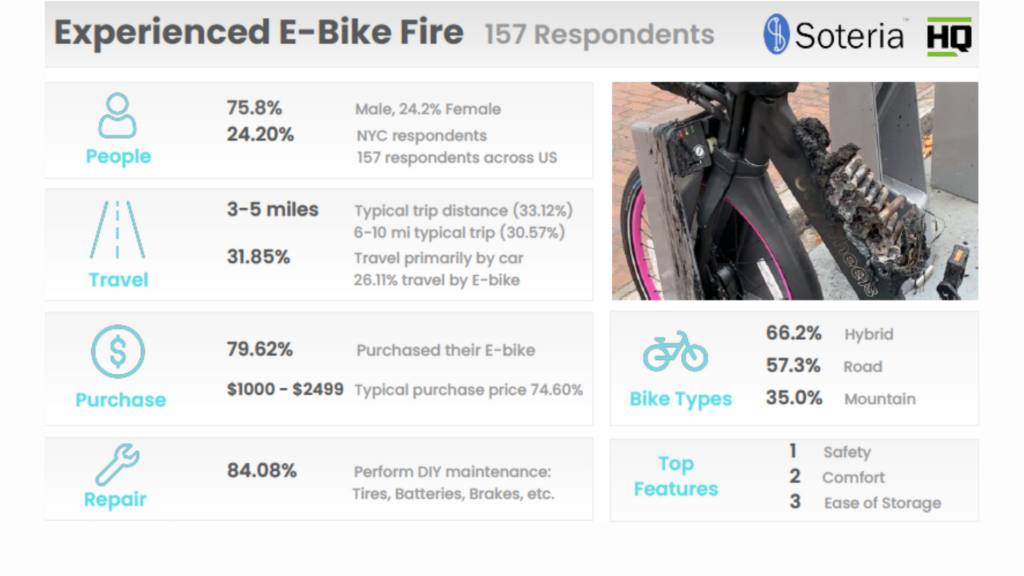Enhancing E-Bike Battery Stability and Safety | Iontra & Salom Europe
Thought Leadership
WHAT ARE CONSUMER’S CONCERNS WITH E-BIKES?
E-bikes are becoming increasingly popular around the world driven by bike share companies in various cities. There are up to 350 million e-bikes in China alone today. However, there are concerns about the safety of e-bike batteries, particularly lithium-ion cells. While the energy density of lithium-ion cells makes them an ideal fit for e-bike applications, there have been well-publicized events of hazardous events with Lithium-ion batteries. The fast growth and adoption of e-bikes globally has also increased pressure on product and component costs, including use of lower-cost batteries.
The top lithium battery incidents sparking concern for the greater public safety are:
- Fire: If a lithium-ion cell is damaged or charged improperly, the cell can enter thermal runaway conditions which in turn cause overheating, and you guessed it, fires. Between 2019 and 2023, the number of fires started by batteries increased by 9X in New York City alone. There have also been an increasing number of serious incidents worldwide in China, UK, Germany and the Netherlands to just name a few countries.
- Toxic Fumes: When burning, the chemicals used in lithium-ion batteries convert into gases that can be extremely harmful if inhaled. This study by mass.gov does a great job explaining the toxicity of gases produced by burning lithium-ion batteries.
- Explosion: In rare cases, battery fires can lead to a full-blown explosion, and require their special procedures to extinguish.
Let’s take a step back – this is not to scare you into never using an e-bike or keep you up at night worrying because your neighbor owns an e-bike. Lithium-ion batteries are generally safe, and many of the companies that use lithium-ion batteries in their products go through extensive testing and certifications to ensure product safety. However, despite both private policy and public regulation, these hazardous events are occurring at an increased rate due to increased adoption. The good news is that there is technology available now to mitigate these hazards and make e-bikes safer.
WHAT IS THE ROOT OF THE PROBLEM?
External factors (misuse, defects) lead to internal breakdowns that lead to Lithium-ion battery fires.
Two such key drivers of Lithium-ion battery degradation and safety risks are
- Charge Methodology: As Lithium-ion batteries are charged, the ions move from the cathode to the anode through the electrolyte and get distributed over the surface. However, with current charging technology, this charge current is not distributed uniformly in the battery, which leads to uneven charge distribution which in turn leads to uneven electrode (and electrolyte) deterioration, lithium plating on the anode and dendrite formation.
- Improper Charging: E-bike and e-scooter battery fires have been associated with faulty charging equipment, improper charging practices, and overloaded electrical circuits. Learn more about the electrical hazards involved with e-bike and e-scooter charging in a recent blog written by a National Fire Protection Association (NFPA) electrical content specialist.
Other causes include
- Temperature Exposure: When a battery is exposed to external temperatures that surpass its specification sheet safe operating temperatures (whether they’re too high or too low), this exposure can trigger internal breakdowns.
- Improper Storage: If the battery is not stored correctly (outside of recommended conditions from the manufacturer), this can also cause issues.
- Manufacturing Defects and Issues: A manufacturing defect or lack of proper testing can lead to sub-optimal chemical makeups which can make the battery more prone to breakdowns.
The external causes mentioned above can lead to three common internal breakdowns:
- Electrode Damage: The battery contains the positive cathode and the negative anode. If electrodes become damaged by lithium plating, punctures, dendritic growth, or a manufacturing defect, it can cause internal shorts. These shorts can cause temperature spikes.
- Unstable Electrolyte: An electrolyte is a liquid or gel solution that enables ions to flow between electrodes. The battery’s electrolyte can be destabilized either by temperature or impurities, and will react with the electrodes, in turn causing electrolyte breakdown, gas release, charging inefficiency and most importantly heat generation.
- Thermal Runaway: Thermal runaway is an uncontrollable, self-heating state of a battery. This is the slippery slope that leads to battery fires. Once thermal runaway begins, the battery’s internal chemical reactions are sent into overdrive, creating a toxic cycle that leads to the battery catching fire and releasing harmful fumes as described below.
When one of the internal breakdowns listed above causes a battery to reach its critical temperature, one of the following events will occur:
- Electrolyte Combustion: The electrolyte, a highly flammable solution, will evaporate and these gaseous chemicals can fuel the eventual fire.
- Separator Breakdown: Think of a separator as a highly porous membrane, like a sponge, that separates the battery’s electrodes. If this separator breaks down, this can allow unregulated contact between the electrodes leading to short circuits
- Release of fumes: In bad cases, the battery may release toxic and flammable fumes which only worsen the likelihood of a full-on explosion especially without proper venting. Lithium-ion batteries in this state eject substances like CO (asphyxiant gas) and CO2 (anoxia inducing) which when heated. When exposed to elevated temperatures, the fluorine contained in the electrolyte and other areas of the battery can produce hydrogen fluoride (HF), another highly toxic gas. Battery fires can emit high amounts of HF, and the use of water as a flame retardant can spark further chemical reactions producing even more gasses, and even spiking HF release.
WHAT IS THE MARKET IMPACT?
To truly understand the market impact of e-bike battery fires, let’s first look at the broader consumer profiles in the e-bike market using data provided by Soteria Battery Innovation Group and TestedHQ. We’ll look at the US market as a proxy. In the survey data provided (see figure 1), the greatest percentage of e-bike owners in the USA listed their e-bikes for recreational use (67.9%). However, this metric is closely followed by the “daily commuter” group (58.9%). From this data, we can determine that the two most common uses for e-bikes in the USA are for facilitating commutes and recreational purposes.

Regarding e-bike fires, 16.83% of recreational riders have experienced a fire, and 12.45% had NO fire protection where the bike was stored. For the daily commuter demographic, 16.83% have experienced an e-bike fire, and 53.22% of respondents DID have fire protection in the area where their bike was stored.
Looking at the macros, of all survey respondents that have experienced an e-bike fire, 84.08% perform DIY maintenance, 71.92% store the bikes in their garage or home, 95.89% charge and store their e-bikes in the same location, and 87.50% have some form of fire protection where the device is stored.
Why is this important?
- The majority of respondents both store and charge their e-bikes in their home or garage
- The majority of respondents perform DIY maintenance to their e-bikes
- A large portion of respondents use e-bike batteries that have been “fixed” or “refurbished” i.e. batteries that are not shipped by the e-bike manufacturer
- 23% of respondents who have experienced an e-bike fire used “fixed” batteries
- 22% of respondents who have experienced an e-bike fire use “refurbished” batteries

While thankfully, the number of users who experience e-bike fires is low, it’s important to note that a considerable number of respondents use after-market batteries and are charging these devices within their own homes.
Given this, it is essential that:
- E-bike batteries should receive rigorous testing to ensure their safety throughout all stages of their lifecycle
- That the charging methods used for e-bike battery packs receive more attention to ensure the safety of the owner, and their home.
The call for safer charging methods is not new, nor is it controversial. We can all agree that user safety is of the utmost importance. So, why do e-bike fire incidents continue to grow? And what is being done at the corporate and government levels to address them?
HOW ARE COUNTRIES RESPONDING?
In response to these concerns, China has recently implemented sweeping new regulations . The new standards regulate the design, production, and sale of e-bike batteries. They aim to address fire risks associated with lower cost and lower quality batteries. The regulations are expected to have a major impact on the US and European market as well, since most e-bike components come from China. Several experts believe that the new rules will lead to a shift towards higher-quality batteries, which will ultimately improve safety for e-bike riders.
The U.S. has also responded to this concern by introducing and passing the ‘Setting Consumer Standards for Lithium-Ion Batteries Act’ in May 2024, which requires the CPSC (consumer product safety commission) established federal safety standards for batteries used in e-bikes and other micro-mobility devices.
However, these regulations do not yet address the charging methodologies that also can impact battery safety and life.
HOW ARE COMPANIES RESPONDING?
Private e-bike companies and groups are taking several approaches to ensuring e-bike safety. These include:
- Higher quality battery sourcing
- Revisit battery management systems (BMS) architectures, which are the systems responsible for monitoring and regulating battery stability.
- Lastly, several interest groups have formed to serve as collaborating forums to solve the e-bike safety problem – one of which is Soteria Battery Innovation Group’s E-Bike project. Soteria has organized an initiative with many of the leading EV and E-bike producers, as well as battery optimization and charging experts, including Iontra, to jointly test cells, identify safety mechanisms and opportunities, and create e-bike best practices that will benefit both the producers and their end users.
IONTRA & SALOM EUROPE TAKING ON THE E-BIKE PROBLEM
In addition to regulations for battery manufacturing, a key need and driver in the growing adoption of e-bikes is safer and better charging technologies. Salom and Iontra are working together to proactively address this issue.
Iontra’ s unique and patented charge control solution delivers a uniform charge distribution in the battery. This in turn protects the anode surface and the electrolyte by eliminating hotspots, and greatly reducing the risk of lithium plating and electrolyte decomposition. This not only increases battery life but also enables safer charging.
Salom is a global leader in innovative, safe power supply and charging architectures for volume applications including e-bike chargers. With their higher performance architectures, including high power USB-PD (power delivery) with PPS (programmable power supply) options, Salom has recognized that embedding Iontra charge control technology in e-bike chargers enhances product safety during the charging cycle whilst delivering additional value in terms of faster charging and extended cycle life. As such, Salom is poised and ready to play a pivotal role in the safe adoption and use of e-bikes globally.
IN CONCLUSION…
E-bikes offer a clean and convenient transportation option, but safety concerns have been a barrier to adoption for some people. But these concerns have not gone unnoticed. In both the private and public sectors, governments, companies, and innovation groups are answering the call for safe, electric transportation.
The new battery regulations should help to address these concerns and make e-bikes a safer option for consumers. Salom Power and Iontra will be key players in accelerating this safety push by thinking outside the battery and bringing the needed innovations in e-bike charging products to market.
Written By: